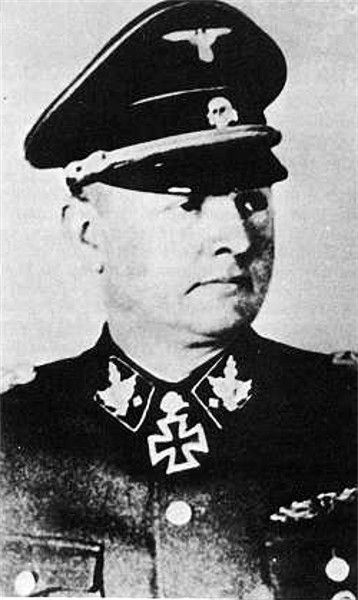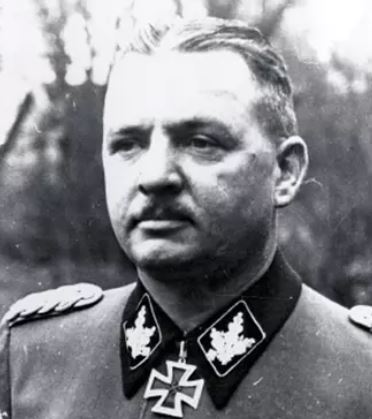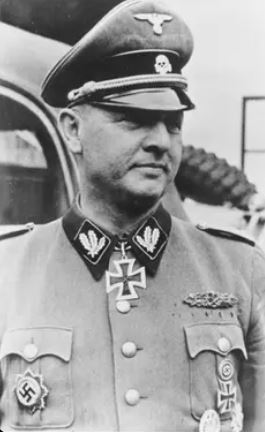Streckenbach, Bruno (Waffen SS)
- Date of birth:
- February 7th, 1902 (Hamburg, Germany)
- Date of death:
- October 28th, 1977 (Hamburg, Germany)
- Service number:
- SS-Nr.: 14.713 // NSDAP-Nr.: 489.972
- Nationality:
- German
Biography
Promotions (Allgemeine-SS/Sicherheitspolizei):
December 24th, 1932: SS-Sturmführer;
June 12th, 1933: SS-Hauptsturmführer;
September 2nd, 1933: SS-Sturmbannführer;
November 9th, 1933: SS-Obersturmbannführer;
April 20th, 1934: SS-Standartenführer;
September 12th, 1936: SS-Oberführer;
April 20th, 1939: SS-Brigadeführer;
January 1st, 1942: SS-Brigadeführer / Generalmajor der Polizei;
November 9th, 1941: SS-Gruppenführer / Generalleutnant der Polizei.
Promotions (Waffen-SS):
January 18th, 1943: SS-Untersturmführer der Reserve;
March 1st, 1943: SS-Obersturmführer der Reserve;
March 10th, 1943: SS-Hauptsturmführer der Reserve;
March 11th, 1943: SS-Sturmbannführer der Reserve;
July 1st, 1943: SS-Obersturmbannführer der Reserve;
August 28th, 1943: SS-Standartenführer der Reserve;
January 30th, 1944: SS-Oberführer der Reserve;
July 1st, 1944: SS-Brigadeführer der Reserve / Generalmajor der Reserve der Waffen-SS;
November 9th, 1944: SS-Gruppenführer der Reserve / Generalleutnant der Reserve der Waffen-SS.
Career:
?: Volksschule;
1908: Realgymnasium des Hamburger Johanneums;
October 1918: Unterprimaner Jungmann-Etappen-Kommando;
February 1919: Oberprimaner Freikorps Hermann;
?: Freiwilligen Wachtabteilung Bahrenfeld;
?: Norddeutschen Heimatbund;
?: Wehrwolf;
?: Fremdsprachenkorrespondent;
1925: Gaugeschäftsführer ADAC, Hamburg;
1928: Verkäufer Stöver-Werken;
October 1st, 1930: Mitglied NSDAP;
December 1930: Mitglied SA;
September 1st, 1931: Mitglied SS;
? - 1932: Autovermietung „Selbstfahrer-Union";
1932: Werbevertreter Automobilbranche;
December 1932: Führer Sturmbann I / 28. SS-Standarte;
1933: Werbeabteilung Norddeutschen Rundfunk;
October 20th, 1933: Leiter der politischen Polizei Hamburg;
?: Leiter Zeitfunkabteilung Norddeutschen Rundfunk;
?: Polizeidirektion München;
October 5th, 1933: Regierungsrat;
February 1st, 1938: Regierungsdirektor / Inspekteur der Sicherheitspolizei und des SD (IdS), Wehrkreis X;
September 1939: Führer Einsatzgruppe 1 / 14. Armee;
November 1st, 1939: Befehlshaber der Sicherheitspolizei und des SD (BdS), Krakau;
June 12th, 1940: Chef des Amtes I (Organisation, Verwaltung und Recht) des Reichssicherheitshauptamtes (RSHA);
July 11th, 1942: Stellvertretender Gerichtsherr des RSHA;
December 1942: Waffen-SS;
January 15th, 1943: Panzerjäger-Ersatz-Abteilung, Hilversum;
March 15th, 1943: Mit den Führung Beauftragd Panzerjäger-Abteilung 8. SS-Kavallerie-Division „Florian Geyer";
?: Panzertruppschule Wunsdorf;
January 10th, 1944: Kommandeur 8. SS-Kavallerie-Division „Florian Geyer";
April 1st, 1944: Mit den Führung Beauftragd 19. Waffen-Grenadier-Division der SS „Latvia" (lettische Nr. 2);
May 10th, 1945: POW Soviet forces;
February 18th, 1954: Convicted to 25 years forced labour, Mosow Military Tribune;
?: Wladimir Prison;
October 10th 1955: Released;
? - June 30th, 1969: kaufmännischer Angestellter und Prokurist, Ottenser Eisenwerk GmbH.
Do you have more information about this person? Inform us!
- Period:
- Second World War (1939-1945)
- Rank:
- SS-Brigadeführer (Major General)
- Unit:
- Führer, Einsatzgruppe I, Sicherheitspolizei in Polen
- Awarded on:
- September 1939
Awarded in September 1939.
- Period:
- Second World War (1939-1945)
- Rank:
- SS-Gruppenführer / Generalleutnant der Polizei
- Unit:
- Chef, Amt I, Personalamt, Reichssicherheitshauptamt
- Awarded on:
- January 30th, 1942
- Period:
- Second World War (1939-1945)
- Rank:
- SS-Gruppenführer / Generalleutnant der Polizei
- Unit:
- Chef, Amt I, Personalamt, Reichssicherheitshauptamt
- Awarded on:
- January 30th, 1942
Awarded in January 1942.
- Period:
- Second World War (1939-1945)
- Rank:
- SS-Standartenführer der Reserve (Colonel)
- Unit:
- Führer, SS-Kavallerie-Regiment 1
- Awarded on:
- September 6th, 1943
- Period:
- Second World War (1939-1945)
- Rank:
- SS-Sturmbannführer der Reserve (Major of Reserves)
- Unit:
- Führer, SS-Panzerjäger-Abteilung, SS-Kavallerie-Division
- Awarded on:
- July 15th, 1943
- Period:
- Second World War (1939-1945)
- Rank:
- SS-Standartenführer der Reserve (Colonel)
- Unit:
- Führer, SS-Kavallerie-Regiment 1
- Awarded on:
- September 25th, 1943
- Period:
- Second World War (1939-1945)
- Rank:
- SS-Standartenführer der Reserve (Colonel)
- Unit:
- Führer, SS-Kavallerie-Regiment 1
- Awarded on:
- October 30th, 1943
- Period:
- Second World War (1939-1945)
- Rank:
- SS-Standartenführer der Reserve (Colonel)
- Unit:
- Führer, SS-Kavallerie-Regiment 1, 8. SS-Kavallerie-Division, Waffen-SS
- Awarded on:
- December 15th, 1943
- Period:
- Second World War (1939-1945)
- Awarded on:
- August 9th, 1944
- Period:
- Second World War (1939-1945)
- Rank:
- SS-Brigadeführer / Generalmajor der Waffen-SS (Brigadier)
- Unit:
- Kommandeur, 19. Waffen-Grenadierdivision der SS (lettische Nr. 2), Waffen-SS
- Awarded on:
- August 27th, 1944
“On the 06.08.1944 the Kampfgruppe 19. Waffen-Grenadier-Division der SS (Lett. Nr. 2) was engaged in combat behind the Aiviekste river (west of Lake Lubana), however it did not have friendly contact to either the left or right as a result of deep hostile penetrations. During the afternoon an attack by a Soviet Division from the north threatened to sever the single retirement road of the Division at a point northwest of Lubana. High command ordered that this penetration be sealed off.
In this precarious situation SS-Brigadeführer Streckenbach made the decision to go over to the attack. He assembled all available reserves (including every last supply driver and clerk he could find) and then personally led a pincer maneuver against the broken-in hostile elements.
Success: Total destruction of 2 Soviet rifle regiments, Division was able to pull back as ordered along the sole available route.
SS-Brigadeführer had been the soul of resistance for his Division since the beginning of its prolonged withdrawal on the 10.07.1944. Throughout this time he rushed from Kompanie to Kompanie in the foremost line, all while rallying wavering units and upholding the combat morale of his Latvian formations. The countermeasures that he executed during this period repeatedly led to notable successes.
His proven personal bravery and leadership qualities make him a particularly worthy candidate for being awarded the Knight’s Cross to the Iron Cross.”
- Period:
- Second World War (1939-1945)
- Rank:
- SS-Brigadeführer / Generalmajor der Waffen-SS (Brigadier)
- Unit:
- Kommandeur, 19. Waffen-Grenadierdivision der SS (lettische Nr. 2)
- Awarded on:
- September 30th, 1944
- Period:
- Second World War (1939-1945)
- Awarded on:
- December 27th, 1944
- Period:
- Second World War (1939-1945)
- Rank:
- SS-Gruppenführer / Generalleutnant der Waffen-SS (Lieutenant General)
- Unit:
- Kommandeur, 19. Waffen-Grenadierdivision der SS (lettische Nr. 2), Waffen-SS
- Awarded on:
- January 16th, 1945
In this particularly critical moment SS-Gruppenführer Streckenbach decided to first order his Waffen-Gren.Rgt. 42 to form a blocking front. At the same time he planned to commit all available forces against the enemy’s main thrust in the left flank of his Division. These included the II./W.-Gren.Rgt. 43, the existing alarm units from the supply troops and the Kampfschule of the Feld-Ers.Btl. Although his right flank was also being attacked at several points he nonetheless pull additional elements from it in order to reinforce his left wing. This risky decision paid off however, as it held up the deep flank of his Division and ensured that the hostile thrust towards the northwest would be temporarily contained.
However the enemy pressure against the deep flank of the 19. Waffen-Grenadier-Division der SS continued to increase throughout the 24.12.1944, and so during the afternoon the divisional commander was assigned the II./Gren.Rgt. 273 of the 93. Infanterie-Division (which had been brought up via motor transport). On the morning of the next day he did not use it to seal off the new hostile penetrations, but rather he used it to deliberately counterattack the flank of this enemy thrust.
This countermeasure again halted the enemy’s thrust to the northwest for the time being, and it also helped buttress the ever-lengthening deep flank of the Division.
This initiative by the divisional commander was the deciding factor that enabled the extended frontline of the 19. Waffen-Gren.Div. der SS to be held for 4 days long despite strong enemy attacks in the front and flank. Such an action furthermore presented the enemy with a dangerous flank threat for their own thrust to the northwest. It was only on the night of the 26./27.12.1944 that the frontline of the 19. Waffen-Gren. Division der SS was pulled back to the Artillerie defensive position due to the situation in the sector of Gruppe Henze.
The Korps’ ability to delay this breakthrough attempt by 6 divisions and 1 Soviet Tank Corps with its own weak forces bought enough time for armoured reinforcements to arrive from other sectors of the Courland front, and once they had arrived it was possible to transition to a more active form of combat.
This outstanding achievement by the 19. Waffen-Gren.Div. der SS (which was notable enough to merit a mention in the Wehrmachtbericht) is largely attributable to the clear and energetic leadership of its commander. He personally directed the heavy forest combat of his Latvians from the vicinity of the regimental command posts, and everywhere he was the soul of the bitter resistance. Captured Russian officers stated that these combat days were some of the worst they had seen in the entire war.
Up until now this Latvian Division has held its ground in an exemplary fashion whilst engaged in defensive combat. It shows clear evidence of having been influenced by the personality of its commander.
The high combat value of his unit can be credited to the decisiveness, energetic leadership and personal devotion to duty displayed by the divisional commander, SS-Gruppenführer Streckenbach.
In these 9 major days of combat the Russians suffered heavy losses in men at the hands of the 19. Waffen-Gren.Div. der SS. They also sustained the following materiel losses to the Division in this time:
1 aircraft (to infantry weapons)
18 tanks (including 8 to close combat weapons)
1 assault gun
18 anti-tank guns
12 trucks
26 medium and heavy mortars
44 heavy machine-guns
156 light machine-guns
Numerous additional war materiel.
104 prisoners were also captured (including 4 deserters).
In these days of bitter forest combat along a wide front, the Division inflicted such heavy losses on 3 attacking Russian divisions that the enemy was forced to call off their assault on the 01.01.1945.
The defensive resolve of this Division laid the groundwork for the crushing defeat sustained by the Russian 22nd Army during the first days of January.”
701st Award.
- Period:
- Second World War (1939-1945)
- Period:
- Second World War (1939-1945)
- Period:
- Second World War (1939-1945)
- Period:
- Second World War (1939-1945)
- Period:
- Second World War (1939-1945)
Sources
- Photo 1: Public Domain
- Photo 2:
- Photo 3:
- - FELLGIEBEL, W.P., Elite of theThird Reich, Helion & Company Limited, Solihull, 2003.
- THOMAS, FRANZ & WEGMANN, GüNTER, Die Eichenlaubträger 1940-1945, Biblio-Verlag, 1998.
- YERGER, M.C., Waffen-SS Commanders, Schiffer Publishing, Ltd., 1999.
- Kurowski, F., Bridgehead Kurland – The six epic battles of Heeresgruppe Kurland, J.J. Fedorowicz Publishing Inc., Winnipeg, Canada, 2002
- Axis Biographical Research
- Microfilm Publication A3343. US National Archives























